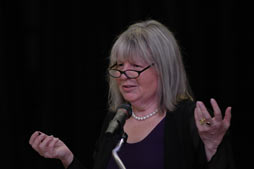By Shalonda Rodgers/reporter

She was a high school English teacher but could not keep her job because she moved around a lot.
Author Susan Cheever visited NE Campus March 27-28 to read excerpts from her work and talk about writing as part of the English department’s annual Living Literature event.
Cheever’s first big break came after she took her first writing job for a small newspaper.
“Even though it was a great job (the small paper), I wanted more,” she said.
In January 2000 Cheever’s agent was asked to find a writer for an introduction to a new edition of the classic 19th century book Little Women. The Louisa May Alcott novel was her favorite book as a child, so Cheever was excited to get the job.
She went on to write for Newsday, The New York Times, The Washington Post and Newsweek.
Cheever’s latest non-fiction book, American Bloomsbury: Louisa May Alcott, Ralph Waldo Emerson, Margaret Fuller, Nathaniel Hawthorne and Henry David Thoreau, is in its second month on the Boston Globe best-seller list.
When Cheever became a writer, it kind of happened backwards. She said she was bad at writing as a child. Her father was a writer, and she didn’t want to be compared to him.
Cheever’s father was not only famous but a well-respected writer. However, she believes her writing didn’t involve genetics.
She believes becoming a writer can happen several different ways and everyone has his or her own path. People one thinks can write good novels, cannot, and those one thinks can’t, can, Cheever said.
Even after her big break, she denied being a writer and referred to herself as a journalist.
After age 35, Cheever said she was better prepared to be a writer. However, life wasn’t perfect.
She dealt with alcoholism for many years until she had her children.
“I conquered many demons and made an art of my struggle as a single mother,” she said.
Cheever provided insight on her “writing process” before and after she had children. Before she had children, she was very organized. She spent three hours answering mail and kept a journal.
Now she has no scheduled system and employs several approaches when it comes to the writing process.
Although very humorous, she thinks her humor is black and a defense against sadness. Cheever said her writing is inspired mostly by negativity, her unusual interest in life and other authors even when they don’t seem like good writers.
For students wanting good books regarding the writing process, she suggested The Elements of Style by William Strunk Jr. and Stephen King’s On Writing: A Memoir of the Craft.
Cheever said writers can use any of several different writing styles and methods with no set time of day. They can work whenever they get the notion to write or have a thought.
It may be helpful actually to visit the place or communicate with people one actually wants to write about, Cheever said.
“You are the god of your story,” she said. “It’s heaven, and you have the power to write it or leave it out.”
Cheever told students not to look at the first draft but to write the second from memory. She said they should take the draft, dissect the heat and put it at the beginning. Last but not least, Cheever said to restructure sentences to develop one’s rhythm.
When writers have a loss for words (writer’s block) they may have to go away and come back.
“Just power through until you are done,” she said.
Rewriting several times can help avoid the worry of plagiarism. Writing a novel can take from one to five years, Cheever said.
“You know you are done when you’re thinking ‘Oh my God, I am a genius,’” she said.
However, once writers look at a publication, Cheever said they visualize how it could have been written differently.
“Self-consciousness is the great enemy of writing,” she said.
Reading is an aid to writing, and reading with someone is always fun, Cheever said. She currently is readingMiddle March by George Elliot with one of her students at Bennington and the New York School.
“A good writer loves to read,” she said. “I don’t like to write as much as I love to read, and I have tons of books.”
Also, writing is about who will work the hardest.
Cheever said writing is not about the writer but what the readers discover about themselves.
“American Bloomsbury opened my mind and made me want to read more,” student Sarah Irvan, said.
Irvan said she was inspired and loved Cheever’s work.
Some of Cheever’s other published works include memoirs: As Good As I Could Be (2001), Home Before Dark(1984), Note Found in a Bottle (1999) and Treetops(1991).
Her novels included Looking for Work (1980), A Handsome Man (1981), The Cage(1982), Doctors and Women(1987) and Elizabeth Cole (1990).
“She brings students in touch with real writers,” Rebecca Balcarcel, associate professor of English, said.
